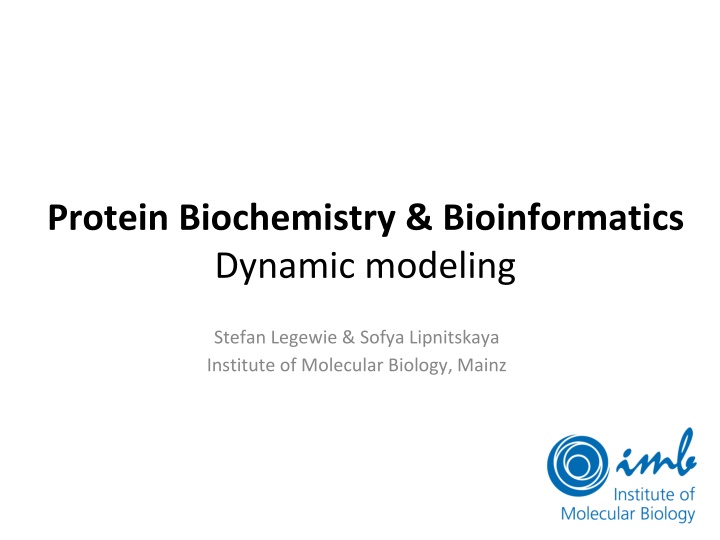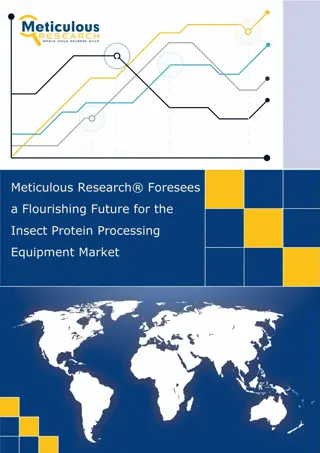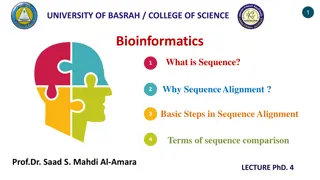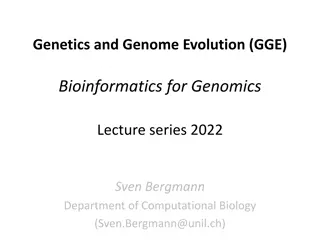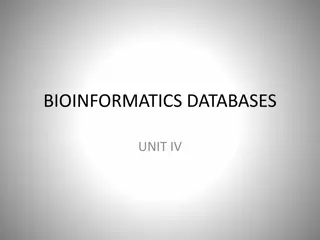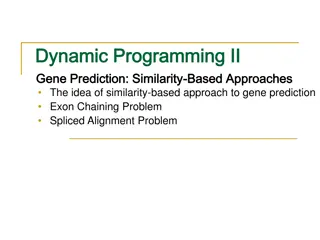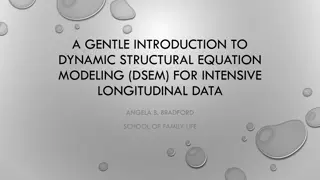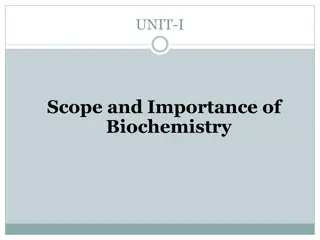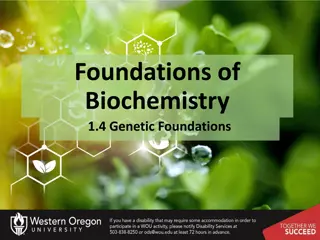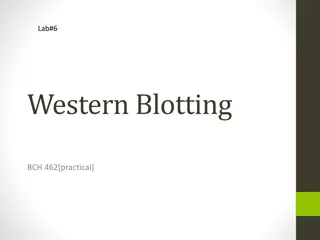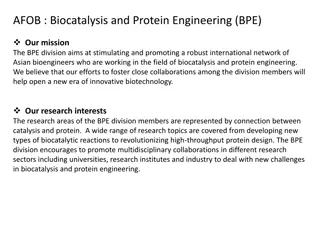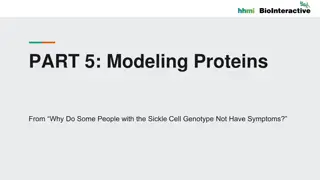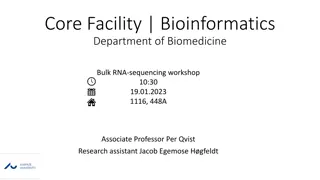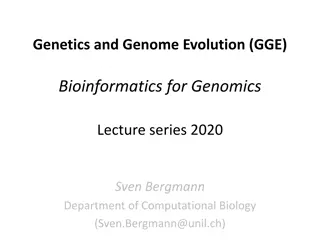Protein Biochemistry & Bioinformatics Dynamic modeling
This publication delves into dynamic modeling in the fields of protein biochemistry and bioinformatics, authored by Stefan Legewie and Sofya Lipnitskaya from the Institute of Molecular Biology in Mainz. The content likely discusses the integration of computational tools and theoretical approaches to study complex biological systems, offering insights into the interplay between protein structure, function, and computational modeling techniques.
Download Presentation

Please find below an Image/Link to download the presentation.
The content on the website is provided AS IS for your information and personal use only. It may not be sold, licensed, or shared on other websites without obtaining consent from the author.If you encounter any issues during the download, it is possible that the publisher has removed the file from their server.
You are allowed to download the files provided on this website for personal or commercial use, subject to the condition that they are used lawfully. All files are the property of their respective owners.
The content on the website is provided AS IS for your information and personal use only. It may not be sold, licensed, or shared on other websites without obtaining consent from the author.
E N D
Presentation Transcript
Protein Biochemistry & Bioinformatics Dynamic modeling Stefan Legewie & Sofya Lipnitskaya Institute of Molecular Biology, Mainz
What is dynamic model of a biological system? (g) Comparison/fitting to data
Iterative cycle of model and experiment Using models for experimental design & refining models based on data Model formulation Experimental validation Model analysis Which network nodes are sensitive to perturbations?
Benefits of dynamic modeling approaches Complex dynamical phenomena Biological robustness Stochastic effects Cellular decision making Oscillations Interpretation of complex datasets Large-scale perturbation screens Multi-level Omics-data
Outline I: Quantitative description of protein expression What determines the kinetics of mRNA and protein expression? How can we describe heterogeneous gene expression at the single-cell level?
Outline II Simple deterministic model of gene expression Modeling circadian oscillators Stochastic model of gene expression captures cellular heterogeneity Stochastic cellular decision making
A simple model for transcriptional regulation of protein expression Assumptions Translation proportional to mRNA concentration First-order decay of mRNA and protein mRNA, Protein ki,di Variables/Concentrations Kinetic parameters
Assumptions underlying ordinary differential equation models Spatially homogenous Cell assumed to be well-stirred Continous Real concentration of mRNAs/proteins Deterministic Average behavior of large molecule numbers
What determines the protein dynamics in response to changes in transcription? Analytical Solution (by integration) Gene ON 1 k1 Gene OFF 0 t=0 time Approximate solution using numerical integration
Time course of mRNA and protein in response to gene activation Gene ON 1 k1 Gene OFF 0 t=0 time System asymptotically approaches steady state
What determines protein expression level at steady state? Steady state = 0 = 0 Exercise 1 Calculate steady state mRNA and protein levels Steady state level set by ratio of synthesis and degradation rates Transcription induces proportional changes in mRNA and protein levels
What determines the protein dynamics in response to changes in transcription? Exercise 2 Plot Protein(t) and mRNA(t) for k1 and d1varied separately Gene ON X k1 Gene OFF Which parameter affects response time needed to reach steady state? 0 t=0 time Which parameter affects the steady state level?
Protein dynamics solely determined by mRNA and protein degradation rates mRNA degradation rate changes final steady state and response time protein degradation rate changes final steady state and response time mRNA and protein synthesis rates change only final steady state
mRNA induction upon to TNF stimulation Schematic pathway representation TNF Hao & Baltimore Nature Immunology 2009 (PMID: 19198593) Target genes
mRNA induction upon to TNF stimulation Schematic pathway representation Quantitative transcriptome profiles TNF Dynamics of target gene expression Hao & Baltimore Nature Immunology 2009 (PMID: 19198593) Target genes Genes decompose into three groups
TNF stimulation induces three temporally ordered gene expression clusters Schematic pathway representation Quantitative transcriptome profiles TNF Target gene expression clusters fast and transient slow and transient slow and sustained Hao & Baltimore Nature Immunology 2009 (PMID: 19198593) Target genes
Adjusting the gene expression model to describe dynamics of clusters NF-kB NF-kB kN mRNA vsyn kdeg 0 2 Ordinary differential equation (ODE) Exercise 3 Adjust model parameters to match the experimentally observed gene expression clusters Hao & Baltimore Nature Immunology 2009 (PMID: 19198593)
Target gene dynamics determined by mRNA half-life NF-kB NF-kB kN mRNA vsyn kdeg 0 2 mRNA Target gene dynamics solely determined by NFkB decay and mRNA half-life unstable mRNA medium stable RNA stable mRNA Hao & Baltimore Nature Immunology 2009 (PMID: 19198593) Analytical solution Numerical solution
Experimental validation: mRNA half- life determines gene expression dynamics Target gene expression clusters mRNA half-life measurement general transcription inhibitor ActD added Hao & Baltimore Nature Immunology 2009 (PMID: 19198593)
What is the relationship between mRNA and protein levels? Peshkin et al Dev Cell 2015 (PMID: 26555057)
mRNA and protein levels do not show a general, simple linear correlation Histogramm protein positive correlation mRNA no correlation Poor overall correlation of mRNA and protein time courses Extensive post-transcriptional gene expression regulation? negative correlation
Model-based analysis of the relationship between mRNA and protein levels Exercise 4 Plot Protein(t) vs. mRNA(t) for fast and slow protein decay Gene ON X k1 Gene OFF 0 t=0 time Normalize Protein(t) and mRNA(t) by their maximal values
mRNA and protein time courses show a parameter-dependent correlation Strong mRNA-protein correlation for rapidly decaying proteins protein mRNA Weak mRNA-protein correlation for slowly decaying proteins protein mRNA Poor mRNA-protein correlation does not necessarily imply post-transcriptional regulation
Most uncorrelated mRNA and protein changes explained by the simple expression model Large-scale analysis simple gene expression model separately fitted to 5800 genes Model fit to data Input: mRNA time course Output: protein time course Fitted parameters free choice of mRNA translation and protein degradation rates Conclusion 85% of all mRNA-protein pairs explained by basic model without the need to assume post-transcriptional regulation measured mRNA time course Peshkin et al Dev Cell 2015 (PMID: 26555057)
Global correlation over all mRNA-protein pairs decreases during dynamic transitions Gene A Gene B Liu et al Cell 2016 (PMID: 26555057)
Summary Simple ordinary differential equation model of describes the dynamics of protein expression mRNA and protein haf-lives determine kinetics and level of protein expression, whereas synthesis rates determine only expression Uncorrelated mRNA and protein changes often arise from delayed protein synthesis and are explainable by protein expression model
Summary: Deterministic modeling with ordinary differential equations (ODEs) Model scheme ODEs mRNA, Protein ki,di Variables/Concentrations Kinetic parameters Assumptions spatially homogeneous concentrations ( well-stirred cell) Sufficiently high molecule numbers/concentrations Steady state condition d(mRNA)/dt = 0 d(protein)/dt = 0 Temporal dynamics can be simulated by numerical integration
Genes are organized in complex networks Gene regulatory network dynamics Single gene dynamics Transcription factor network controlling monocyte differentiation FANTOM consortium, 2009
Protein expression in a more complex network: Circadian rhythms
Circadian rhythmicity is established by a gene regulatory network with negative feedback
Circadian rhytmicity is established by a gene regulatory network with negative feedback 24h oscillations in Per2 expression single-cell Luciferase reporter system fibroblasts Liu et al., Cell 2007
The Goodwin oscillator a negative feedback model of circadian rhythmicity Exercise 5 Implement negative feedback model and plot Z(t) for the following parameters k1= k3=k5=1 k2= k4=k6=0.1 Ki=1, n=10 Goodwin oscillator Ordinary differential equations Per2 mRNA Per2 protein Per2 protein Gonze et al., PLoS ONE 2007
Effect of parameter changes: how does protein degradation influence the oscillator period? Exercise 6 What is the effect of increasing the protein degradation rate? k1= k3=k5=1 k2= 0.1, k4=k6=0.2 Ki=1, n=10 Goodwin oscillator Ordinary differential equations Per2 mRNA Per2 protein Conclusion: Faster protein degradation shortens circadian period Per2 protein Gonze et al., PLoS ONE 2007
Human sleep disorders are caused by mutations in the circadian clock network Familar advanced sleep phase syndrome (FASPS) FASPS mutations in Per2 phosphorylation sites Increase Per2 protein degradation Shorten the circadian period Leloup and Goldbeter, Bioessays 2008
Detailed model of FASPS mutation effects confirms relation of oscillator period with Per2 protein stability Per2 phosphorylation and degradation Auto- repression Nuclear translocation Principle of period determination by protein half-life translates into clinically relevant setting! Vanselow et al., Genes & Dev 2006
Role of cooperative feedback inhibition in maintaining stable oscillations Exercise 7 What is the effect of reducing the cooperativity factor n? k1= k3=k5=1 k2= k4=k6=0.1 Ki=1, n=3 Goodwin oscillator Ordinary differential equations Per1 mRNA Per1 protein Conclusion: Cooperative feedback required for oscillations Per1 protein Gonze et al., PLoS ONE 2007
Summary: requirements for oscillatory behavior in biological systems 1. Negative feedback loop 2. Time delay determines oscillation period Set by mRNA/protein half-life 3. Strong and cooperative feedback Brown et al., Dev Cell 2012
Oscillations due to negative feedback shape decision making in the p53 tumor suppressor network DNA repair -irradiation Apoptosis Singl-cell response Digital decision making * Dynamics of the p53-Mdm2 feedback loop in individual cells. Nat Genet(2004).Lahav G,..,Alon U.
Outline: Quantitative description of protein expression What determines the kinetics of mRNA and protein expression? How can we describe heterogeneous gene expression at the single-cell level?
Analysis of gene expession at the single-cell level more informative higher throughput
Gene expression a stochastic process Stochastic dynamics shown for transcription initiation and elongation Randomness arises from low molecule numbers! each cell contains few copies of each gene transcription factors often present in low amounts
Stochasticity in gene expression revealed by dual reporter experiment in E. Coli Strong variations in fluorescence confirm the existence of gene expression noise Elowitz et al., Science 2002
Intrinsic and extrinsic sources of gene expression variability Fluctuations in biosynthetic machinery (polymerases, ribosomes) Eukaryotes Random binding of transcription machinery to each promoter (low copy numbers!) Bacteria Eukaryotes Elowitz et al., Science 2002
Stochastic models account for event probabilities at low molecule numbers Deterministic ODE model vs. Stochastic model Average behavior of large molecule numbers Probabilistic behavior (randomness) at the single-molecule level Continuous: Concentration of mRNAs/proteins Discrete: Absolute molecule counts
Stochastic version of simple protein expression model Reactions occur with certain probabilities mRNA and protein given as absolute molecule count (discrete) Simulation by Gillespie algorithm selects most probable next reaction updates molecule counts
Simulated temporal evolution of mRNA and protein in a stochastic model
Time-scale of stochastic mRNA fluctuations depends on RNA degradation rate Slow mRNA decay Fast mRNA decay
How do protein fluctuations depend on mRNA and protein synthesis rates? Exercise 8 Plot protein fluctuations for various transcription and translation rates while keeping average expression constant Quantify the noise by calculating the coefficient of variation (CV=std/mean) and histogram of the time courses
Fine-tuning of noise a given expression by changing transcription and translation rates Obzudak et al., Nat Genet 2002
